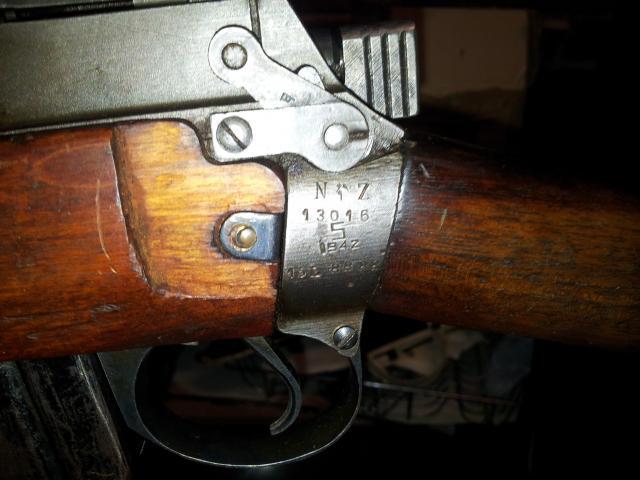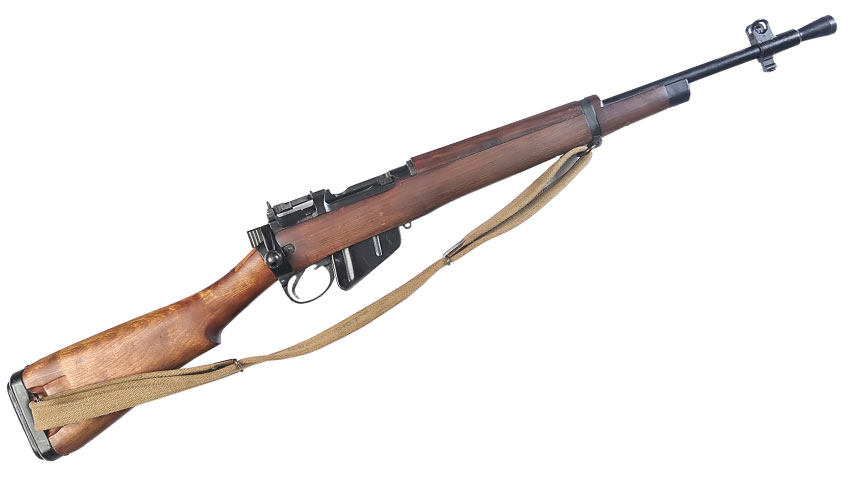
The Lee–Enfield is a bolt-action, magazine-fed repeating rifle that served as the main firearm of the military forces of the British Empire and Commonwealth during the first half of the 20th century, and was the British Army's standard rifle from its official adoption in 1895 until 1957. Fixed and adjustable aperture sights incorporated onto later variants Sliding ramp rear sights, fixed-post front sights, "dial" long-range volley telescopic sights on sniper models.

1 were fitted with five shot magazines as standard but could be ordered with ten shot magazines if desired. The rifle was fitted with Parker-Hale sporting front and rear sights and drilled and tapped for Parker-Hale side mounts for a telescopic sight. The charger bridge was removed so the action was brought back to its original clean profile as designed by James Paris Lee. This rifle had a new sporter stock with Monte Carlo comb, Parker-Hale rubber recoil pad and contrasting rose-wood pistol grip cap and fore-end tip with white line spacers. 1 was much more modified and consequently more expensive but still kept around the £20 price point. 1 was also kept stock standard but fitted with an actual sporting style stock complete with Monte Carlo comb as was fashionable in the sixties. 1 was a stock standard military rifle with the fore-end shortened the Supreme No. As can be seen from the catalog pages above the Standard No. Parker-Hale’s sporting rifles based on the Lee-Enfield No.

Parker-Hale sold some rifles in stock standard military condition for full-bore target shooters, some were re-barreled with target grade barrels, and some were re-built into sporting rifles in various grades and provided nice quality sporting rifles for less than £20 back in the sixties.Ĭatalog pages for the Parker-Hale sporting rifles based on the No. So, after the Second World War when large numbers of Lee-Enfield rifles were sold off by the British government as surplus a large number of them were bought up by Parker-Hale to sell to sporting shooters in Britain, Australia, Canada and the United States. The fact that it is cock on closing was no impediment to it in combat and is no impediment out deer or pig shooting either. The Lee action is smooth, reliable, and easy to cycle quickly. As a combat rifle it was without doubt superior to Paul Mauser’s model of 1898, and the things that made the Lee action so good in combat don’t suddenly vanish when we sporterize the rifle and take it out hunting. This action that saw service in both world wars and rather a lot of other conflicts and emergencies along the way well and truly proved itself. (Picture courtesy ).Īmerican James Paris Lee’s rifle action did not go down in history as “the best bolt action combat rifle ever created” for no reason.

A look at the grain pattern between the fore-end wood and fore-end cap seems to indicate that the fore-end cap on this rifle is genuine. Some claim that the “rosewood” fore-end is fake achieved by putting a white line into the wood and staining the fore-end cap a different color. 1 was probably the prize model of the various offerings. This was not a particularly accurate perception to have and it took a while and some maturing of my thinking before I started to appreciate the Lee-Enfield rifle for the modest masterpiece that it is.
#1942 LEE ENFIELD NO4 MK1 STOCK PROFESSIONAL#
So I tended to see them as an inexpensive “knock around” rifle for farmers and professional kangaroo shooters.

The “expert” information I absorbed led me to believe that the Lee-Enfield action was “not as strong as a Mauser 98” and that “they don’t shoot accurately”. Back then I was new to the shooting sports and so I talked with other shooters and did lots of reading of things by shooting “experts” and formed my ideas around that information. The vast majority were locally sporterized military surplus rifles of varying provenance and quality. By then I was living and working in Australia and the Lee-Enfield sporting rifles were plentiful and cheap. I didn’t get seriously into shooting until I’d graduated college and had my first “real job” in the early seventies.


 0 kommentar(er)
0 kommentar(er)
